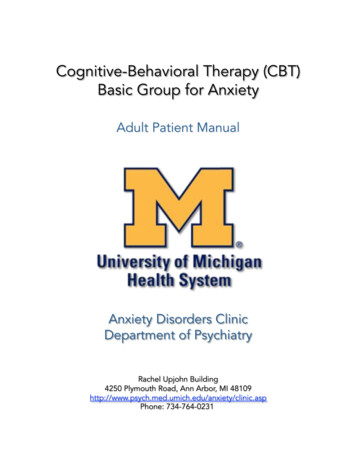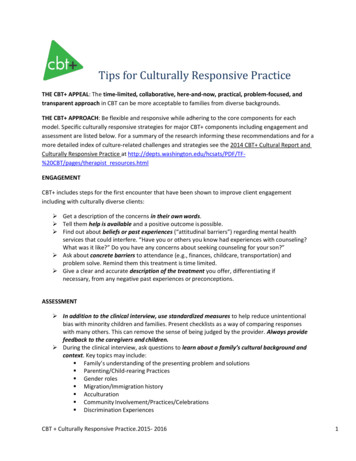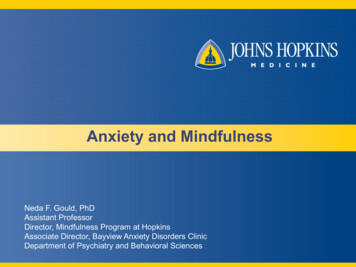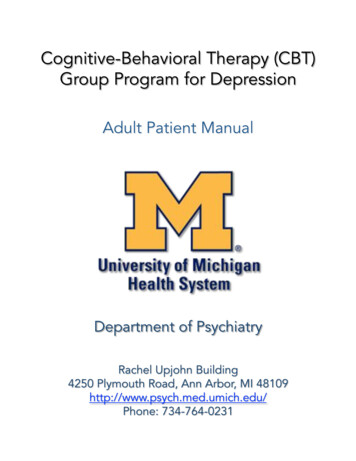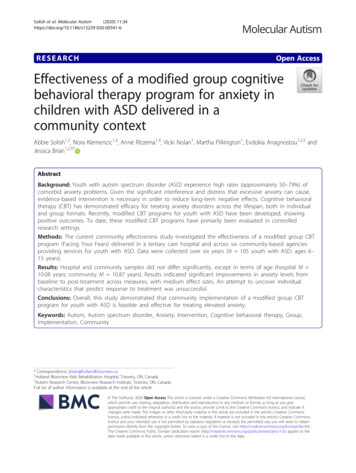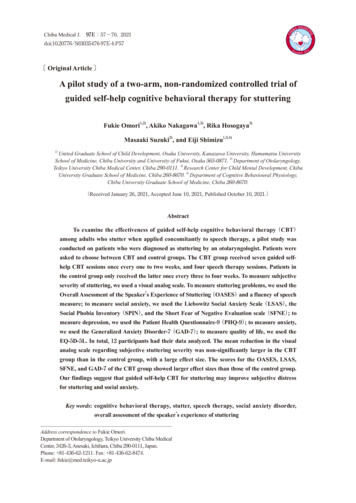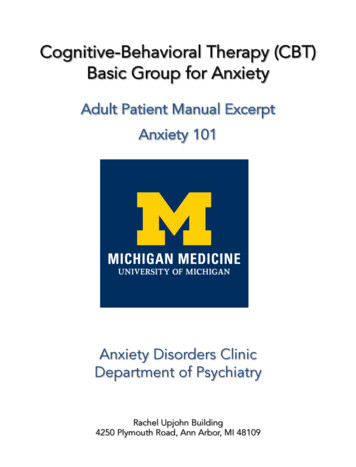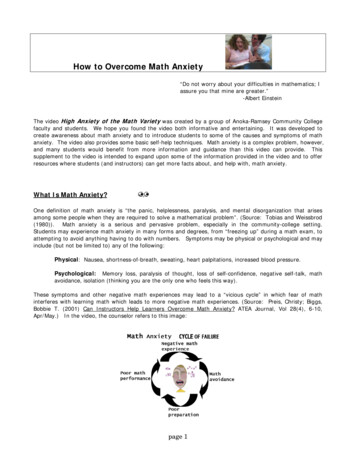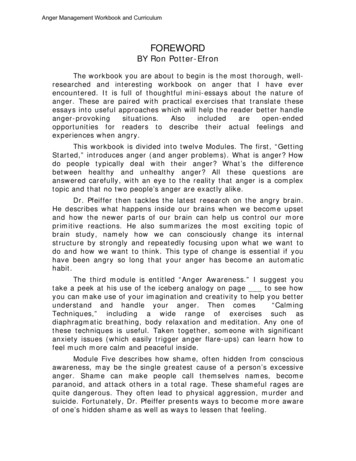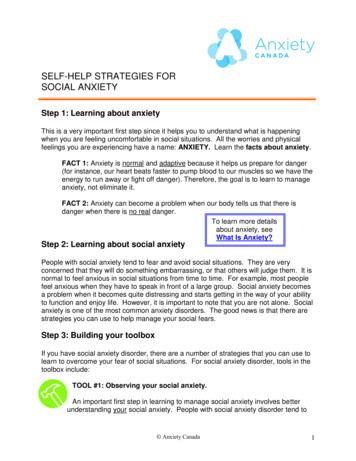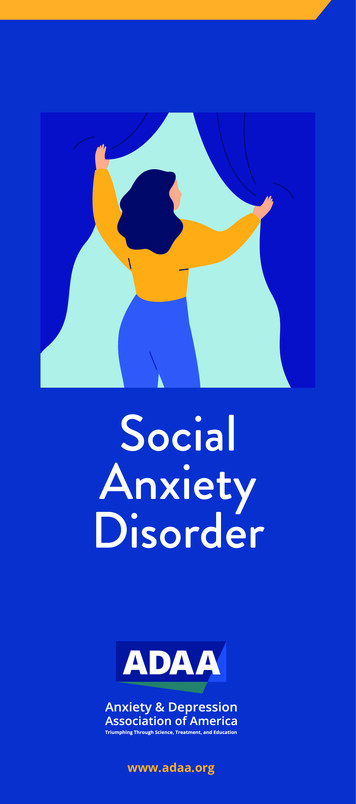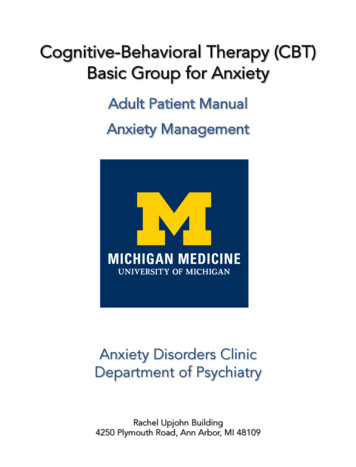
Transcription
Cognitive-Behavioral Therapy (CBT)Basic Group for AnxietyAdult Patient ManualAnxiety ManagementAnxiety Disorders ClinicDepartment of PsychiatryRachel Upjohn Building4250 Plymouth Road, Ann Arbor, MI 48109
AcknowledgementsCognitive-Behavioral Therapy (CBT) Group Program for Anxiety Patient ManualWritten by Dan DeSena, LMSW, DMAEditors:Pam Schweitzer, APRN, BCLaura Lokers, LCSWRicks Warren, PhDBased in part on the knowledge and expertise of:James Abelson, MD, PhDJoseph Himle, PhDLaura Lokers, LCSWPam Schweitzer, APRN, BCRicks Warren, PhDi.
AcknowledgementsCognitive-Behavioral Therapy (CBT) Group Program for Anxiety Patient ManualParts of this manual were broadly adapted and integrated from the followingsources about anxiety, Cognitive-Behavioral Therapy, and group psychotherapy:Barlow, D.H. & Craske, M.G. (2007). Mastery of your anxiety and panic, 4th Ed. New York:Oxford.Beck, J.S. (2011). Cognitive therapy: Basics and beyond (2nd ed.). New York: Guilford Press.Craske, M.G., Antony, M.M. & Barlow, D.H. (2006). Mastering your fears and phobias, 2nd Ed.New York: Oxford.Craske, M.G. & Barlow, D.H. (2006). Mastery of your anxiety and worry, 2nd Ed. New York:Oxford.Craske, M.G., Treanor, M., Conway, C., Zbozinek, T. Vervliet, B. (2014). Maximizing exposuretherapy: An inhibitory learning approach. Behaviour Research and Therapy, 58, 10-23.Davis, M., Eshelman, E.R. & McKay, M. (2008). The relaxation & stress reduction workbook, 6thed. Oakland: New Harbinger.Foa, E.B., Yadin, E. & Lichner, T.K. (2012). Exposure and Response (Ritual) Prevention forObsessive-Compulsive Disorder, 2nd Ed. New York: Oxford.Hope, D.H. & Heimberg, R.G. (2010). Managing social anxiety: A Cognitive-BehavioralApproach. 2nd Ed. New York: Oxford.LeDoux, J. (2015). Anxious: Using the brain to understand and treat fear and anxiety. New York:Penguin Books.Rothbaum, B. & Foa, E.B. (2007). Prolonged Exposure Therapy for PTSD: Emotional processingof traumatic experiences. New York: Oxford.ii.
Cognitive-Behavioral Therapy (CBT) Basic Group for AnxietyGroup GuidepostsWhat is this group all about? Our group is an introduction to the basic conceptsand skills of CBT. There are four sessions, each with a different topic. You can attend these in any order you like. Each session will cover just some of these CBT skills.If you have questions during the group, please ask!It is also possible any confusion you have at thebeginning will clear up as you continue to attend thesessions. This group is not meant to fix your anxietycompletely. We want to give you a chance to try outsome of these techniques and understand youranxiety better. When you get done with this groupyou may want to continue with group or individualCBT treatment here or with a therapist in thecommunity.What is Cognitive-Behavioral Therapy?Cognitive-Behavioral Therapy (CBT) is a short-term,evidence-based treatment for many problems,including anxiety. It is based on the principle thatcognitions (thoughts), behaviors (actions/choices)and emotions (feelings) all affect each other. Beingaware of and changing how we act, think, andrespond to emotions can help us keep anxiety fromcontrolling our lives.Feelings (emotions)Thoughts (cognitions)Weekly Group topics:Anxiety Vulnerability Management (week 1)Do you ever think you have more anxiety thanother people? Find out why and learn how touse CBT skills to fight your anxiety over thelong term.Relaxation and Mindfulness (week 2)Just relax! What to do and when to tryrelaxation strategies to help make you feel lessstress and tension in your daily life.Exposure and Desensitization (week 3)“Avoid avoidance:” how our behaviors canmake anxiety worse, and the surprising way tolearn to manage it!Cognitive Therapy Skills (week 4)Our thoughts matter! Learn ways our thoughtscan change how we feel and influence whatwe do. Turn thoughts into your ally, instead ofyour enemy.We want to be sure that our treatment iseffective!Evidence-based means that there is scientificevidence to show that something works.CBT is an evidence-based treatment that hasbeen studied and shown to be effective inhundreds of scientific experiments.Behaviors (actions)While there is no 100% guarantee that CBTwill work for you, it is likely that with practiceand hard work you will receive benefit fromthese techniques.How to use this manualThis manual includes a lot of information on anxiety and CBT—more than we have time to cover in the group sessions. You will getthe most out of this group if you take notes during the group and then review the manual between sessions. Remember thatdifferent people get benefit from different CBT skills, so we expect that you will use the skills that work and let go of the rest. Wehope that you will try each skill out to determine if it suits you. Refer to “Appendix Iii: This is so much information! Where do Istart?” to make your reading more efficient by starting with the information most pertinent to your particular problem. Finally, besure to bring the manual back next week!iii.
The Path Through Psychotherapy There is a great deal of scientific research onpsychotherapy, and we know a lot about whatcan be helpful for people. We continue tolearn more and more about how to usepsychotherapy to help as many people aspossible.However, because everyone is different, andour brains and lives are very complex, it isoften hard to know exactly what it is that willhelp a particular person feel better.On the next page, follow thepath from the bottom of thepage upward for some tips tomake your “path throughpsychotherapy” more helpfuland rewarding.iv.
v.The Path Through Psychotherapy, con.See this as just one piece of the puzzle in your process of better understandingyourself and moving toward what you want in your life. Get all you can out of itand then make efforts to find out what other types of work could be helpful. Forexample, maybe you did a great deal of work on managing your anxiety withcognitive and behavioral skills. Now you believe that you want to improve yourrelationships to achieve more in that area of your life.Manage barriers to showing up regularly to treatment and practicing skills: improvementdepends primarily on follow-through and the amount of work you put into your therapy.Address anxiety from different angles. There is no one “silver bullet” that willchange anxiety all by itself. Usually a “combination treatment,” or mixed approachis what works best to make anxiety better. This also means putting in some effortto understand different ways to manage your anxiety.Practice skills over, and over, and over. It usually takes time for changes in ourbehavior and thinking to lead to us feeling better. Like learning a musicalinstrument, we are practicing new ways of doing things that will feel “clunky” atfirst, and become more comfortable over time.Take small steps toward change each day. Try not to wait for “light bulbmoments,” “epiphanies,” or for something to take anxiety all away instantly.Expect ups and downs during the process. Think of it as “2 stepsforward, 1 step back.” Try not to get discouraged or give up whenthings seem to move backward or stagnate.Make it about you: engage in your treatment because you want to improve your life.Take responsibility for achieving your aims to feel better, not because others are tellingyou to do so. Remember that even if you are being pushed to engage in therapy bysomeone else, that relationship must be important enough for you to consider thisoption!Maintain an open mind about the possibility of change, while being realisticabout how fast this change can happen.Especially at first, gauge success according to how you change your responses to stress,uncomfortable emotions, and body sensations, not whether or not these things exist orcontinue to occur. Focus on valued action, even more than just “feeling better.”“Credibility:” Make sure the treatment in which you are engaging makes sense toyou and seems to be addressing your problem. There are different paths to thesame goal. If this type of therapy is not working for you, you are confused aboutwhat you are doing, or you have any other concerns, talk to your clinician rightaway. Clinicians are trained to have these discussions with their patients.Make sure your definition of the “problem” is the same as the clinician’s withwhom you are working. Maybe they think it is “anxiety” and you think it issomething else. Try to clarify this with your clinicians.
Anxiety ManagementManaging the “Tug of War” with anxiety and stress“Courage is resistance to fear, mastery of fear—not absence of fear.” Mark TwainNow that we’ve learned about many of the skills you’ll see in CBT, let’s talkabout how to put them all together. This section uses the analogy of a “tug ofwar” to describe our battle with anxiety and stress over time. The informationin this section helps us approach treatment of anxiety in a realistic, effectiveway. This especially applies to treatment of anxiety over long periods oftime—periods in which it is inevitable that we will experience stress of somesort or another.We talk about the balance between risk andprotection that underlies each decision we make,and how these decisions make us more or lessvulnerable to anxiety. We also spend time in thissection discussing what “causes” anxiety, the riskfactors that make us more vulnerable to it, includinggenetics and stress.We briefly discuss some “other” CBT skills for anxiety, problem solving andacceptance skills.At the end of this section we also describe the CBT treatment optionsavailable to you at the University of Michigan Anxiety Disorders Clinic to helpyou with the next steps in your journey to free yourself from anxiety.5.1
Tug of War: Managing Anxiety Over the Long TermThink back to the last time you had a “tug of war” at a fair or on the beach. Your team has some influence on theoutcome; but the other team may (or may not ) make things hard for you to achieve your aim.Managing anxiety over the long term can sometimes feel like a “tug of war.” Despite our attempts at creating a happy,comfortable life, there is always the possibility that some “external stressor,” like an accident, job loss, or interpersonalconflict, could arise. One important goal of CBT skills is to give us confidence that we can cope with these unexpectedstressors when they happen.The opponent in a game of “tug of war” is as integral to the game as stress is to our lives. And just as it is in the game,we can only win if we participate. Participation in the game of life means accepting stress and finding ways to manageit to achieve our life aims. The diagram below may help you to understand how to use CBT skills to assist you in your“tug of war” with stress.To the left are stressors that are often outside of our control; on the right are the coping skills we need to keep theanxiety from interfering with our life aims.onaInterpersconflictsntss: Pare sictenGeentndparor gra nxietywith aDeath ofloved onesJob lossBig lifechangeslAccidentsPhysicalIllness“Positive” stressors suchas marriage, childrendesive episoDepressshipf a relationBreakup oto aMovingenew homressorsFinancial stPost-partumanxiety or depressionUse exposure skills to confront anxiety provokingsituations actively. Use Cognitive Therapy Skills tounderstand a situation as realistically and in asdetailed a way as possible to determine how likelyand how dangerous a situation could be. Theseskills work to “reprogram” the anxiety responseand are the most powerful CBT skills to changeanxiety feelings in the long run.Practice relaxation skills regularly to address anxietyby slowing down breathing, reducing muscletension, and quieting the mind.Find ways to add“pleasure” and“mastery” to yourdaily life. These arethe things we livefor!Take care of yourself!Consider issues ofself-care to give theanxiety less of anedge.Use problem solving skills to proactively addressproblems you can control, and acceptance skills tolet go of things you can’t control.5.2
“Tug of War,” continuedAnother way to look at our battle with stress and anxiety is to try to balance a normal desire for protection with a hopeof achieving certain life aims. This may seem like an abstract concept, so let’s look at some specific examples ofbalancing risk with life aims.Should I take the chance? Or How often do you drive or ride as a passenger in a car? Probably every day! Automobileshave changed how we live our lives; they are convenient and help us achieve our life aimsquickly and efficiently. It is hard to imagine living without them.Of course, driving or riding in a car involves some risk. According to the United StatesDepartment of Transportation, there is a 1 in 84 chance of being killed in an automobileaccident at some point in our lives. So why do we take this risk?It must be worth it to take this chance. We take the small risk of getting into an accident inorder to take advantage of the benefits automobile travel can afford us. Of course, the factthat getting into an accident is relatively unlikely certainly helps!Every day we take risks to reach our life aims. While we probably aren’t noticing thisprocess, we have “pros and cons” playing in our head about most decisions we make.Check out the example below:“Cons”Pros and Cons: Driving or Riding in a Car1. Small chance of getting hurt or killed in anaccident2. Costs associated with driving (gas, repairs,etc.)“Pros”1. Get to destination faster2. Accomplish more of my goals each day: work,daily chores, fun and hobbies, etc.3. Increase number of activities that are available tomeAs the above example illustrates, our lives are filled with decisions about when to take risks and when to protectourselves. Usually we are trying to find a balance between protection and risk. We try to have as much as we can withoutincreasing the chance of harm too much. There are many options. Below, we illustrate this continuum and decisions wemake that move us more toward risk (and more freedom) or protection (and less freedom). It is our choice to decide howmuch risk to take. Most people try to find a reasonable balance between risk and protection.Greater risks, fewer precautions, more freedom, better quality of lifeDrive with “reasonable safetybehaviors” in place (balancebetween risk and protection:- Drive safely: moderate speeds,drive with the flow of traffic, etc.-No multitasking while driving-Keep car in good repair-Take defensive driving classes-Be careful when there is badweather“These are the things I enjoy and I won’tlet anxiety take them from me. It is worthtaking that small chance to have some ofthe things I want.”Drive with no concern for safety at all(too much risk):“There is no risk here; nothing badcould happen to me. I don’t need tobe careful.”No driving at all (complete protection):“It is best to be safe and prevent bad thingsfrom happening at all costs.”“I would rather not do that if it is going tomake me feel anxious.”“I want to take all precautions to be surethat everything will be OK.”Fewer risks, more precautions, less freedom5.3
“Tug of War,” continuedNature or nurture? Revisited In the “Anxiety 101” section of this manual we briefly discussed the causes of anxiety. While there are many factors thatlead to an anxiety problem, we know that our vulnerability to anxiety is related to both “nature” and “nurture.” Nature iswhat we inherit from our parents: our genetics. Nurture is life experiences. Risk factors (genetics or experiences thatmake one more “at risk” for developing anxiety) are a mixture of these two basic elements. Below we list some of themost common risk factors for anxiety.“Nature”and“Nurture”Early life experiences:Patterns of attachment withparents, early life stress, traumaticexperiences early in life, etc.Modeling from importantelders/authority figures:learned protective behaviors, ideasabout what is/is not dangerous, etc.Genetics: inheritedvulnerability tophysical and/ormental illnessTraumatic experiences: accidents, assault,deaths of loved ones, near deathexperiences, being attacked by an animal,etc.Learned patterns of cognitive inflexibility (rigidthinking), such as extreme criticality orperfectionism“I Want Control!”Most of us work hard to maintain some control overour lives: we plan, protect, and organize our lives sothey are more predictable and feel safer.Patterns of uncertainty in treatment by others:Abuse or neglect during upbringing, moving frequently from areato area, unpredictable parentingWhile there are some things in our lives that we can successfully control, there are other things that we cannot. In fact,we may find that the more we try to control some things, the more this control eludes us.One thing that is very hard to control completely is our body; sometimes it seems as if we experience a constant influx ofpain, anxiety, emotion, and thought. The truth about these automatic impulses is that we cannot completely controlthem, no matter how hard we try. Once a thought comes into our head, it is there; once an emotion happens, ithappens. As we have learned earlier in this manual, trying to get rid of thoughts and feelings often makes them lastlonger or grow in intensity. However, our responses to these impulses can influence how we experience the anxiety inthe future. We use skills learned in CBT to influence the anxiety in this way.It is for this reason that in CBT we frame anxiety management as an effort to influence the anxiety, through skills andadaptive responses to it, rather than to “control” it. Complete control is impossible, but at the least we can manage thesymptoms of anxiety, which are likely to come up from time to time. Look at the quotations below to further understandthis difference.Influence“While my decisions have a part to play in how things turnout, there are some things out of my control.”“I can’t prevent thoughts and feelings from happening, butmy responses to these impulses can influence how Iexperience the anxiety in the future.”“Learning to cope with hardships is a part of life. I canrespond well to make it the ‘best case scenario’, whateverhappens.”Control“If I work hard enough, I can make things just right.”“I need to be sure everything will be safe at all costs.”“If there is even the slightest chance something bad could happen Ido not want to do it.”“I hope nothing bad happens today.”5.4
“Tug of War,” continuedExercise #1: “How I can balance my anxiety vulnerability with coping skills”Skills I can use to manage anxiety and balance myvulnerabilityVulnerability factors(Check the ones that apply to you)Genetics (family member with anxietyor depression)Exposure skills (confront anxiety to desensitizetriggers and achieve aims)Traumatic experiences (especially in early life)Cognitive skills (challenging negative automaticthoughts)Modeling of important elders/authority figures(how we learn what is/is not dangerous)Relaxation strategies (slow diaphragmatic breathing,mindfulness meditation, etc.)Learned patterns of cognitive inflexibility (rigidthinking such as extreme perfectionism)Self-care (exercise, diet, sleep, manage illnesses, limituse of substances, etc.)Patterns of uncertainty in treatment by others(parents, elders, etc.)Mastery and Pleasure (time to enjoy activities, achievelife aims)Problem solving and acceptance skills (adaptively addressproblems and accept things we cannot controlExercise #2: See the connection between stressful life events andanxiety/depressionThink about times in which you were particularly anxious or depressed an write them on the left. What externalstressors were going on at the time? Write those on the right. While our own anxiety sensitivity is one factor indeveloping an anxiety problem, stress usually plays a role!Time of life (e.g. “When I was 16”)External stressors (e.g. grandfather passed away)“Tug of War” Take Home Points:Managing anxiety over the long term can feel like a “tug of war;” as we have experienced stressin the past, it is also likely to come up in the future. One important goal of CBT is to understandour vulnerability to anxiety and use coping skills to offset this vulnerability.We all have to find our own balance of “risk” versus “protection” to achieve our life aims. Whilewe all would like to be completely safe, there is always some risk in each decision we make. WithCBT we learn what risks are worth taking to reach our aims.5.5
5.6Problem Solving and Acceptance: the “other” CBT SkillsWhen a problem arises, there are many possible responses. As we have discussed throughout thismanual, some responses to anxiety and problems can help to solve these problems; others canserve to make things worse. Below we describe three ways of addressing a problem. One approachmay work best, or all three may apply. The “take home point” here is that all situations are different,and require different types of approaches to help you meet your life aims.Adaptive Response #1: Problem solving (actions/behaviors)Sometimes the best answer to a problem is working to “solve” the problemsomehow—it is not a problem with our thinking or behavior, it is a problemwith the external circumstances. For example, if someone is consistentlyaggressive or abusive of us, we may want to find a way to set firm limits withthat person or leave the relationship altogether. There are many problemsolving skills, some of which are outlined below:-Exposure skills to address avoidance-Assertively address interpersonal conflicts-Take small steps to make progress on long-term projects-Plan for the future-Manage your time effectively-many others Talk to your therapist or group leader about other behavioral skills to directlyaddress problems that arise.Adaptive Response #2: Get the facts (thinking)How to takeaction to solve aproblem1. Write down clearlywhat the problem is.2. Brainstorm aboutways to solve theproblem, even“ridiculous” ways,writing down allpossibilities.3. Rank the possiblesolutions in order, frombest to worst. Think“how likely is it for thisapproach to work?”Use cognitive skills to better understand the “facts” of a situation. Perhapsthere is a problem, and perhaps there is not. Sometimes the first step is tounderstand the facts of a situation, and then decide whether or not to useproblem solving skills (above) or accept things that are outside of our control(below). See the section on “Cognitive Therapy Skills.”4. Decide on a plan ofaction for eachreasonable solution.Rate how probable itwould be that each planwould work.Adaptive Response #3: Accept what cannot be controlled (lettinggo)5. Pick the mostreasonable plan and putthe plan into action. If itdoesn’t work, go to thenext best solution andtry that one. Continue totry until you solve theproblem.There are times that we believe we should be able to controlsomething, yet our consistent attempts to do so are met with failure.This “beating a dead horse” makes us more and more frustrated, angry,anxious, and depressed. Sometimes letting go of things we cannotcontrol is necessary to prevent problems from getting even worse; wealso lift some of the burden of failing over and over.How do I know what to do to make it better?Sometimes it is difficult to know which approach to take to make a situation better. While it is ultimately anindividual decision, one that may take trial and error, therapy is a place to work out some of these difficultchoices. The various skills in CBT are meant to help us get some clarity around some of these decisions.While we don’t have room in this manual to discuss in detail how to make these decisions, this is somethingto discuss with your group or individual therapist as you move through treatment.
What can CBT Treatment Look Like?Cognitive-Behavioral Therapy is an effective, evidence-based treatment that has been proven to have animpact on anxiety in both the short and long term. Below we explain some of what to expect from CBTtreatment.Cognitive Behavioral Therapy is regular. It works best when you come to treatment once per week for most of the treatmentcourse. It is common to go to once every other week or once a month once the symptoms have beenreduced and you have entered the “maintenance” period of treatment. typically lasts for between 12 and 16 sessions. Depending on the problem, it may take more orless. This is not a treatment that is meant to last for significant amounts of time. is structured. This is not the style of therapy in which one comes into the session only to “vent” orhave someone with whom to talk. The treatment is focused specifically on treatment aims, whichusually include reducing the impact of anxiety on our lives and feeling better, by learning skills andtechniques to respond to anxiety when it arises. has a variety of skills. As you may have noticed from this manual, there are different ways tomanage an anxiety problem. Most people find it helpful to use a variety of skills, instead of searchingfor just one “silver bullet.” There is most likely not just one answer to your anxiety problem. However,the anxiety symptoms can usually be managed well if one practices multiple skills repetitively overtime and incorporates them into the flow of daily life. requires practice. Call it homework, daily practice, or whatever you choose. Regardless, it takesdaily repetition to learn skills and retrain one’s anxiety response. A rule of thumb is to expect tospend about one hour a day practicing CBT in between sessions. We want you to feel better outsideof sessions and after you finish treatment, not just while you are at our clinic. depends on follow-through. The most important factor in whether or not treatment works is theamount of work you put into it. Consider it an investment in a future with more freedom andflexibility. is collaborative. Individual and group CBT are structured, but are also centered around your lifeaims. The patient and therapist work together to define treatment targets, adapt skills to the patient’sunique circumstances, and troubleshoot as barriers arise. If certain skills do not work, it is common totry others. If something does not seem to be working, one can discuss this with the therapist or groupleader. Communication is an important part of CBT. is evidence-based. This means that the concepts and skills are based on scientifically-validatedconcepts, and the interventions have been tested to be sure they are helpful.5.7
Notes
Notes
Notes
Notes
What is Cognitive-Behavioral Therapy? Cognitive-Behavioral Therapy (CBT) is a short-term, evidence-basedtreatment for many problems, including anxiety. It is based on the principle that cognitions (thoughts), behaviors (actions/choices) and emotions (feelings) all affect each
